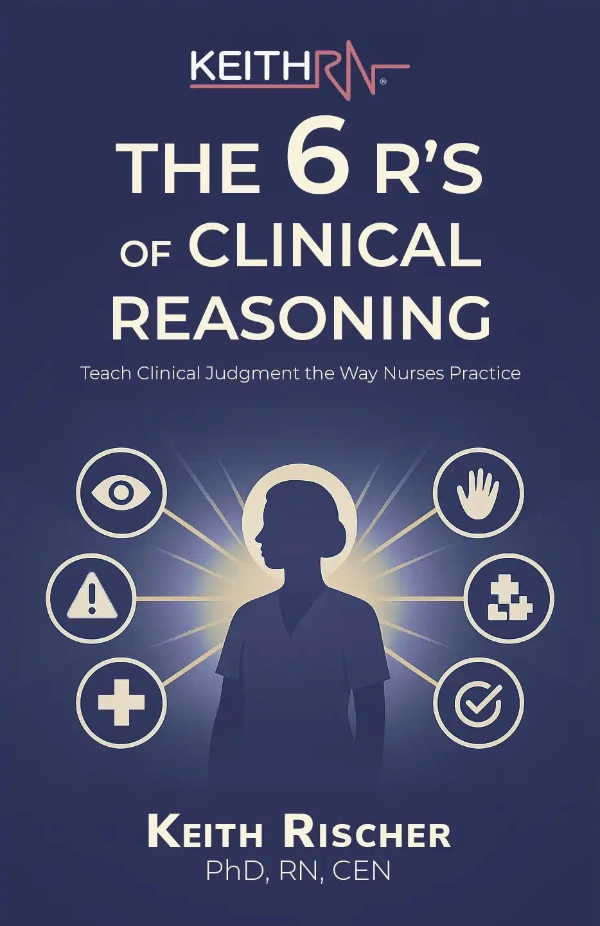
The Real Reason They’re Struggling
If you’ve ever stood at the front of a nursing classroom and wondered why your students keep showing up unprepared, you’re not alone. You spend hours lecturing, reminding them to review the syllabus, answering the same questions you already covered in class, and still, someone asks for a study guide the week before the exam.
Another student challenges a test question you know was crystal clear. You try to help them think through the material, but instead, they just want to know what page it’s on.
It’s frustrating, and I get it.
But from my tutoring chair, I see the other side, too, the students who are exhausted, working hard, and still feel like they’re running in place. They’re not trying to be lazy or difficult; they’re genuinely lost. They want to understand nursing, but feel overwhelmed and lost when it comes to thinking like a nurse.
That’s usually where I come in.
What I See From Both Sides of Nursing Education
Over the past sixteen years as a professional nursing tutor, I’ve had a front-row seat to both sides of nursing education.
I’ve listened to my own nursing school mentors, colleagues, and the many educators I continue to engage with in places like KeithRN’s Teachers Transforming Nursing Education Facebook community.
I’ve also heard from thousands of nursing students across the country: traditional students whose parents hire me, adult learners balancing full-time jobs and families, English-as-a-second-language students fighting through imposter syndrome.
From this unique vantage point, I watch trends in real time as they spread across nursing programs. And one of the most troubling patterns I’ve seen recently is the rise of learning-light, time-heavy assignments.
Yes, I’m talking about the explosion of online modules from large vendors. (You know the ones I’m talking about…)
They’re nothing new. And in theory, these modules aren’t evil. But the way they’re being implemented has become a big problem for our future nurses.
Student Stories
One of my students, an adult learner with an advanced non-nursing degree, calculated it would take her more than nine hours to complete the assigned modules for one week of one class. This didn’t include any time to complete non-module assignments, textbook readings, or independent study.
Another student’s program added a second online module brand to their weekly requirements. When he discussed it with me, I recommended that he politely bring his concerns to his professor.
When he did, taking the time to share realistic time estimates of how long the online modules were taking, his instructor told him to just “Figure it out.”
These examples aren’t coming from bad instructors. They’re coming from dedicated professionals doing their best under intense pressure and less-than-ideal working situations. And if requiring more and more online modules (or similar assignments) was effectively training nursing students to be successful nurses, there would be no problem.
But they’re not. And even worse, they’re becoming ‘busy work’ that pretends to make things easier for educators, but instead interferes with real learning.
What “Busy Work” Really Means
When I talk about “busy work,” I’m not just referring to online modules or endless worksheets.
Busy work is any activity that doesn’t move students closer to the number one goal of nursing school: learning how to think like a nurse.
To be fair, there’s a subset of students who can successfully learn that skill even through the busy work. These are the rare few who instinctively turn every task into active learning, whether they’re reading a textbook, watching a lecture, or yes, even completing a boring online module.
Unfortunately, that’s the minority. It’s not fair or realistic to expect everyone else to just “study harder” until it finally clicks. And yet, that’s what most students try to do.
For most nursing students, “studying harder” is the equivalent of running faster and longer on a treadmill. But if they stay on the treadmill, they’re never going to reach any destination except burnout. And don’t we already struggle with that enough in the nursing profession?
Students Still Struggle
I once worked with a student who had been failing exam after exam despite doing everything right. She went to office hours, reviewed her tests, completed remediations, and asked her instructor what else she could do.
Her instructor, who genuinely cared, kept reassuring her, “Don’t worry, it’ll click.” But after her fifth failed exam, the instructor finally said, “I don’t know what else to tell you, you’ve done everything I suggested.”
That’s when she found me. I taught her the Silver Bullet Study System I developed, and she passed her next exam two weeks later. Unfortunately, the math was against her; she couldn’t recover enough points to pass the semester. But for the first time, she knew what to do differently and had the confidence that it would work.
Her instructor didn’t lack compassion; she lacked a concrete framework to turn an abstract goal (“think like a nurse”) into something her student could actually do.
And when both students and educators feel powerless, it triggers fear, along with the natural instinct to do more: more tasks, more readings, more remediation, and yes, even more online modules.
All in the hopes that something finally clicks.
The Fear-Based Teaching Trap
While it’s obvious how students can easily fall into fear-based studying, it’s just as easy for educators to default to fear-based teaching. After all, you care about your students and want to see them succeed!
And just like doctors who prescribe unnecessary antibiotics when a worried parent begs them to do something about their child’s viral illness, nurse educators and administrators are tempted to ‘take action’ by piling more work onto students.
It’s all well-intentioned. After all, accreditation standards, NCLEX pass rates, and patient safety are serious responsibilities. So we start measuring success by what’s easiest to count, hours logged, modules completed, questions answered, and simultaneously risk burying the very learning we are trying to encourage.
In our race to help the students, we’ve forgotten that “more” doesn’t automatically translate to “better.” In fact, less is often more effective, but only when it aligns with our true goals: improving critical thinking and developing clinical judgement.
In the end, nursing students will respond to the learning environment we create. That means if you want to get them off the ‘study harder’ treadmill and actually learning to think like a nurse, then you need to do something a little different, too.
Two Simple Shifts You Can Try in Your Next Class
Action Step #1: Explain Bloom’s Taxonomy Early and Often
It’s easy to forget that most students have never even heard of Bloom’s Taxonomy, much less have a full pedagogical understanding of how it affects nursing exams. All they know is that multiple-choice questions are suddenly much harder than any other class they’ve ever taken.
This problem is compounded by the newly popular advice to “dump your PowerPoint slides in ChatGPT and ask it to quiz you.” But when ChatGPT not-so-helpfully responds by asking questions only at the remember/understand levels of Bloom’s Taxonomy, students don’t know the difference.
This creates a false sense of security, leading them to think they’re prepared for their next test, only to be surprised when they can narrow it down to two answers and choose the wrong one again.
Taking a few minutes to explain Bloom’s Taxonomy with real examples empowers your students to make smarter, more informed decisions. You also alleviate chronic test anxiety by reassuring them they’re not crazy or dumb, the multiple choice questions really ARE harder. And once they understand why, you may even discover that post-exam answer-key arguments decrease, too!
Action Step #2: Review What’s “Normal,” Because Nothing Else Makes Sense Without It
It’s one thing for students to understand the how (Bloom’s Taxonomy) and why (to think like a nurse!) behind their exams. It’s another thing to connect the two so students can succeed. Like so many other things in life, I’ve found the key is to return to the basics.
And that means starting with normal.
While we’d love to believe that nursing students remember every important detail from Anatomy & Physiology, we all know most of that knowledge has already been ‘brain-dumped’. It’s tempting to say, “They should already know this!” or “I don’t have time to review it!”
However, the truth is that you don’t have time NOT to review normal. Without a strong foundation of how things normally work, it’s impossible to understand and think through more complex clinical scenarios.
I learned this lesson early, when I was still a student and the only peer tutor in my program. A professor referred their student to me for help with cardiac Med-Surg. Since I hadn’t taken that class yet, I wasn’t sure I could help, but I was willing to try.
I quickly realized she was clueless about the normal A&P of the heart and lungs. I sent her home with instructions to memorize it; when she returned, she easily understood the symptoms of heart failure with very little additional explanation.
Best of all, she understood those symptoms without memorization and was able to logically connect them to the subsequent nursing actions.
When you take the time to ensure your students know ‘normal’, either by teaching it directly or requiring a pre-class assignment, you’re building a solid foundation for everything else they need to learn.
But that’s only the first step.
 Key Takeaway
Key Takeaway
Without a strong understanding of NORMAL physiology and how body systems work, it’s impossible to understand and think through more complex problems encountered in clinical scenarios.
Turning Busy Work Back into Brain Work
Reviewing normal is crucial, but it’s only the first step. Once students have that foundation, they can finally begin really practicing how to think.
But only if you, as the nurse educator, can guard against busywork.
That’s why you should treat your assignments like training wheels: there to guide and support your students as they learn to think like experienced nurses until they can do it on their own.
Resist the urge to parrot commonly shared, abstract advice unless you can back it up with concrete action steps students can immediately implement. If you’re not sure where to start, or can’t imagine adding one more thing to your already full schedule, you’re welcome to use the same method I developed: the Silver Bullet Study System (SBSS).
The Silver Bullet Study System is a simple, repeatable framework that guides students to think through topics like experienced nurses do, using 4 simple questions:
- What do I need to know about normal before I can study this topic?
- Based on what I know about normal, what has broken or changed?
- Based on what broke/changed, what do I predict will happen next?
- Now what are we going to DO about it?
It’s straightforward, but powerful. Once students try it, they become independent self-learners who can identify the most important information, connect the dots, and change their focus from memorization to understanding.
Best of all, both learning and teaching become fun again.
 Pause & Reflect
Pause & Reflect
Are your students spinning their wheels through modules and worksheets, or are they really applying what they learn to think more like nurses?
What one small change can you make this week to shift from task-based assignments to purposeful, clinical reasoning activities?
Closing Thoughts
At the end of the day, none of us became nursing educators to assign more busy work! We did it to help students reach their dream of becoming amazing nurses.
And when we bring our teaching back into alignment with that purpose, everything else, understanding, confidence, clinical judgment, and even joy, starts to fall into place.
Together, we can turn busy work back into brain work and build the next generation of confident, capable nurses.
Nicole Whitworth, RN, BSN
Nicole is a registered nurse and founder of Your Nursing Tutor, where she’s spent over a decade helping nursing students think like a nurse—not just pass tests. She created the Silver Bullet Study System, a framework that replaces busy work with meaningful learning that builds clinical judgment.
If you’d like to learn more, you can access her free Silver Bullet Study System Overview at YourNursingTutor.com/help. It’s a short, practical resource you can review on your own and share with your students to walk them through this process.
The Ultimate Solution to Develop Clinical Judgment Skills
KeithRN’s Think Like a Nurse Membership
Access exclusive active learning resources for faculty and students, including KeithRN Case Studies, making it your go-to resource.




